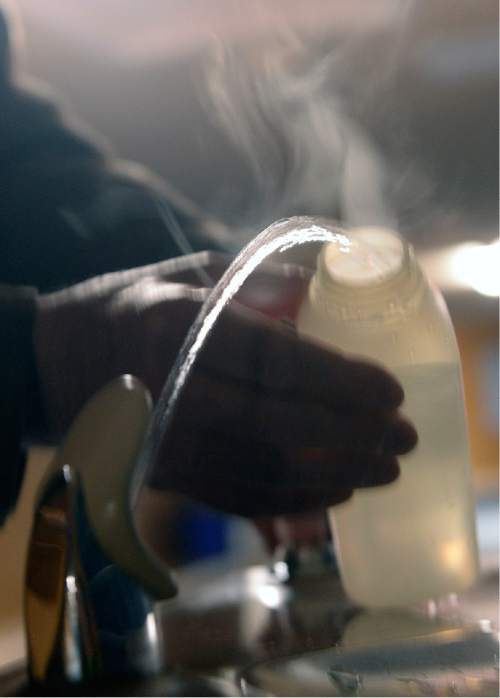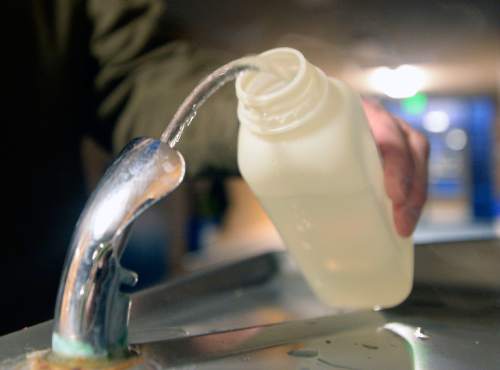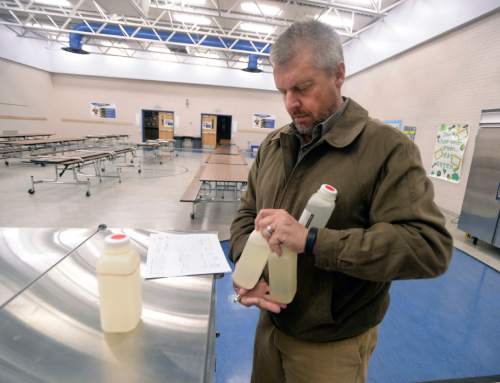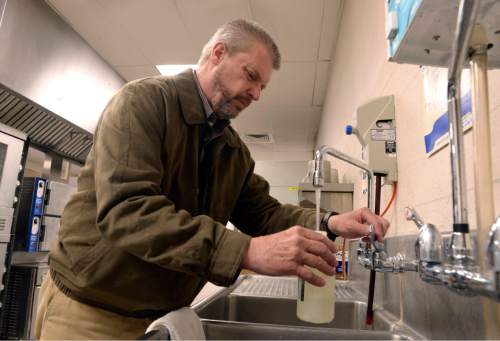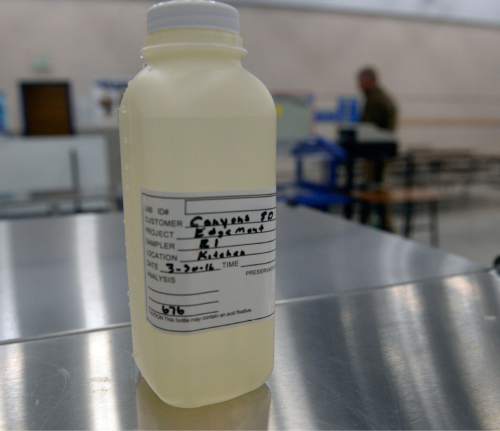This is an archived article that was published on sltrib.com in 2016, and information in the article may be outdated. It is provided only for personal research purposes and may not be reprinted.
Kevin Ray, the risk management coordinator for the Canyons School District, was up at the crack of dawn last month to collect water samples at Edgemont Elementary in Sandy. The school's custodian had noticed discolored deposits in the school's toilets and sinks and raised concerns about contaminated water.
A few weeks earlier, a similar scenario played out at Spring Lane Elementary. A parent, alarmed by his kids' complaints about the school's orange water, collected samples of the school's water and sent them for independent testing. The school also sent for its own test.
The results revealed that the drinking water at the two schools — located miles apart and served by separate water systems — contained concentrations of iron that exceeded Environmental Protection Agency standards, as well as lower, nontoxic levels of copper and lead.
It's uncommon for drinking water to be contaminated with dangerous levels of lead at the source, but the metal can concentrate in drinking water when lead leaches out of old pipes and fixtures — like those in the many Utah homes and schools built before 1986, when lead was federally banned from use in drinking-water pipes.
This localized source of contamination may not be detected by the surrounding water system's routine tests, and few local schools have programs that regularly monitor the quality of on-site drinking water.
"You've undoubtedly heard about Flint ... that is a situation where this very thing has happened," said Kenneth Bousfield, director of the Utah Division of Drinking Water.
—
An orange canary • In Flint, "the water provided to the homes was meeting the standards, but because it was a more aggressive water — more aggressive than nearly any water system — the water was hungry, and it went to eat the pipes," Bousfield said.
Most water in Utah isn't "aggressive," Bousfield said; it's hard water, which contains a lot of dissolved minerals and doesn't easily absorb new minerals, metals or contaminants — making it better for drinking than soft water.
Water devoid of dissolved minerals is less stable — "hungry," as Bousfield likes to term it — and can corrode pipes, resulting in leaky plumbing and, potentially, contaminated drinking water.
Lead and copper, due to their historical use in drinking water lines, are two of the most common contaminants that enter drinking water this way, Bousfield said, but neither is visible when present in water.
The far-less-toxic iron, on the other hand, often tints water an orange-brown hue, acting as a sort of water-quality canary.
So when Ray got the call about orange deposits on toilets at Edgemont Elementary, he was quick to respond, arriving at the school at 6:30 the next morning to collect four samples, one from the kitchen sink and three from drinking fountains.
"I took a paper towel and hit that and it came right off the bowl, an orange residue," he said after collecting samples. "That's most likely iron from the pipes — it doesn't necessarily represent a problem, but could be indicative of other problems. We'll look for iron, lead and copper in the samples."
All four samples exceeded the EPA's recommended limit of .3 milligrams of iron per liter of drinking water.
Concentrations of iron higher than the EPA standard can result in an unpleasant taste and may stain plumbing fixtures and clothing, but iron is toxic only in exceptionally high doses — doses far higher than what students were likely exposed to.
The samples also contained copper — the highest came in at 1.21, just below the EPA's maximum level of 1.3. Copper can harm infants and individuals with certain metabolic disorders at higher levels by damaging the liver and kidneys, according to the EPA.
Low levels of lead were also detected in two of the four samples.
—
Getting testy • Schools are not subject to the same stringent monitoring requirements imposed on the systems that deliver drinking water. But the 1988 Lead Contamination Control Act does require schools to identify and address any contamination caused by pipes, plumbing fixtures, drinking fountains or coolers, which once used lead-lined components to chill water.
According a 2011 seismic risk survey, 58 percent of Utah's schools were built prior to 1975 — a decade before the Safe Drinking Water Act went into effect. But water quality testing in local schools appears to be sporadic.
Of the five districts in Salt Lake County, four — Granite, Canyons, Jordan and Murray — said they order water quality tests if there are complaints of a bad taste, odor or discoloration.
Salt Lake City School District's communication officer, Jason Olsen, said the district does not test drinking water because the water supplied to the schools "undergoes extensive testing by the organizations who supply the water, as is required by law," and because additional testing is not legally required.
All of the schools in his district also have newer copper water lines, Olsen said, which contain less lead than the galvanized steel pipes common in buildings constructed prior to the 1950s.
Other school districts in Salt Lake County said they had not kept records of their water tests because there is no legal requirement to do so, and were unsure how often actual testing had occurred. Steve Dunham, a spokesman for the Jordan School District, said his schools had conducted tests three or four times in the last 18 months. To his recollection, none of the tests came back positive for metals, he said.
Only Canyons School District said it has attempted to keep records of the water tests conducted at its schools — and, unfortunately, those records were lost when the laboratory responsible for them caught fire in 2014, said Jeffrey Haney, a district spokesman.
The exact implementation of the 1988 rule was left to the states' discretion and, according to the EPA educational materials, school monitoring and compliance has varied widely across the country.
Utah chose to respond by holding training sessions for school facilities managers to inform them of the act's requirements and educate them on proper testing protocol.
"When it first came out," Bousfield said, "I arranged to meet with the physical facilities manager at every school district in the state, and I told them this is the act, this is what you must do. They had mixed reactions."
Though regular monitoring is not considered an explicit requirement, an EPA spokesman said the agency strongly recommends that schools implement a program for regular water quality monitoring, and that they test their water independently, as the majority of municipal water quality tests are at residential locations.
The agency has even produced a 100-page guidebook for schools, which calls pipe corrosion "the critical issue." School procedures, according to the EPA, should involve "the three Ts": training of officials; testing drinking water; and telling students, parents, staff and the community about water monitoring programs and their results.
—
Spring water • Lance Peacock said he became concerned about the water quality at Spring Lane Elementary more than two years ago, when his two children began to complain that the water looked funny and had a bad taste.
When he first asked about the water, he said, school officials told him that there was a problem with a boiler or water heater that would be remedied.
He wanted to take samples then, but said the school wouldn't allow it.
The situation became so frustrating to Peacock that in late February he decided to covertly collect his own samples and order his own water quality tests.
Both of his samples exceeded the EPA's .3 milligram per liter recommendation for iron; the highest of the two contained 5.41 milligrams of iron per liter.
Both samples also tested positive for copper and lead, with the highest result coming in at .365 milligrams of copper per liter and .0131 milligrams of lead per liter.
Exposure to lead is associated with developmental delays in children, and the EPA does not consider any amount of lead in drinking water to be safe. But water-system administrators are not required to take action until lead levels exceed .015 milligrams per liter.
After Peacock's February complaints — which Benjamin Horsley, communications and community outreach director for Granite School District, said is the only water-related complaint Spring Lane has received — Granite School District conducted its own water quality tests at the school.
All four of those samples exceeded the EPA's recommendations for iron; the highest measured .66 milligrams of iron per liter. Lead was also detected, with the highest sample measuring .0029 milligrams per liter. The school's test results did not include data on copper.
—
Canyon water • After Edgemont Elementary's March test results came back showing low levels of lead, copper and iron in the water, Canyons School District took advantage of spring break, earlier this month, to install water filters on all taps and fountains that distribute drinking or culinary water, Haney said.
The filters appear to be working, he said; in subsequent samples the highest concentration of iron had dropped to .06 milligrams per liter.
If the filters hadn't worked, the district had planned to truck in water for students when school resumed.
The age of school buildings has been an ongoing concern in the Canyons District, Haney said. When the district was formed in 2009, the average school building was 41 years old, and a study concluded the aging buildings needed some $6 million in repairs.
Since then, he said, 13 schools have been rebuilt or have received major renovations.
In schools that have not received renovations, said risk-management coordinator Ray, he typically watches for signs of corrosion in pipes more than 30 years old.
The results at Edgemont Elementary, built in 1958, have prompted the district to order a round of water testing at schools built in the same era — Eastmont Middle, Bell View Elementary, Peruvian Park Elementary and Alta View Elementary — to determine whether they might also show signs of pipe corrosion.
So far, only Bell View's water testing is complete, and came back negative for metals.
—
"The water is not unsafe" • Spring Lane has also installed filters on its drinking fountains, a move Horsley emphasized was not a reaction to the water quality tests but an attempt to placate Peacock's complaints about the water's appearance and taste.
"We tried to bend over backwards to help this gentleman understand that what they are seeing has nothing to do with water safety," he said.
The district also sent a letter to Spring Lane parents that explained the iron level overage and the modifications to the drinking fountains, while emphasizing that there was no immediate health concern for the students.
The letter did not disclose any other test results.
About a month after the filters were installed, the Utah Division of Drinking Water conducted additional tests at Spring Lane at the request of Granite School District.
The division collected 13 samples from various locations around the school, including classroom faucets and the sink in the cafeteria.
One sample, collected from one of the drinking fountains originally tested by the district, exceeded EPA standards for iron and copper, measuring .352 milligrams of iron and 2.111 milligrams of copper per liter.
All 13 samples contained low levels of lead; the highest — from the same drinking fountain with the iron and copper — registered .006751 milligrams per liter.
Horsley said the Division of Drinking Water advised the district to flush the drinking fountain's water tank and test for metals again. Initially, he said, the district did not have time to do so and instead took that drinking fountain out of service until it could conduct follow-up testing.
That test found the concentration of copper had dropped to .191 milligrams per liter. Lead and copper were at or below the minimum reporting level.
Peacock said these later rounds of tests and results were never shared with parents. Granite School District does not believe the situation ever posed a threat to the health of students, Horsley said.
"The water is not unsafe," he said. "This is just something that happens to buildings with galvanized piping, which is why we are switching over to copper pipes,"
According to Granite records, Spring Lane is one of more than two dozen schools in the district where old-style galvanized steel pipes are still in use. Horsley said the school is on a shortlist for renovation, which should happen this summer.
Spring Lane was scheduled for renovation last year, he said, but the district ran out of funding.
epenrod@sltrib.com Twitter: @EmaPen



